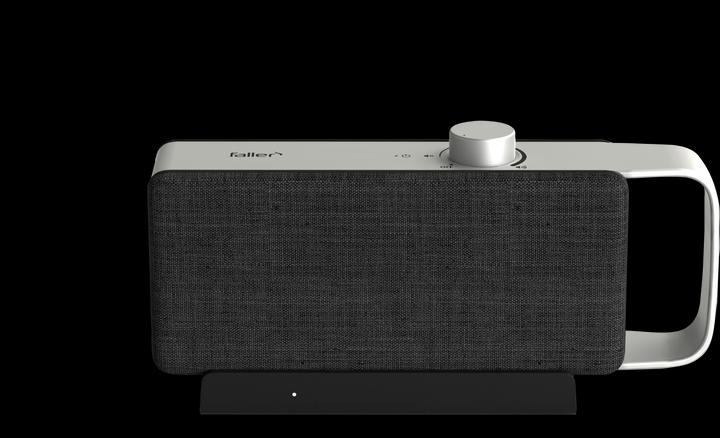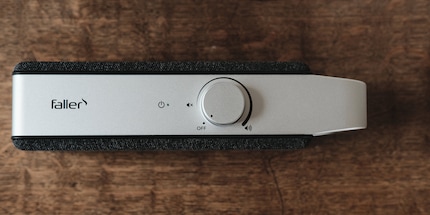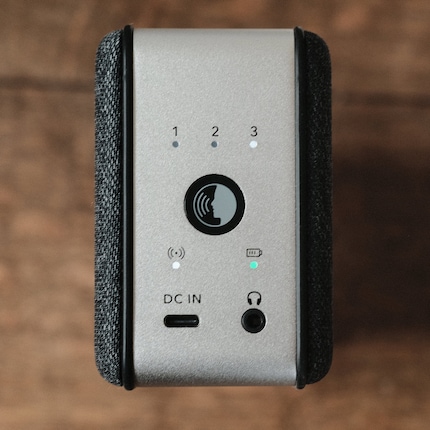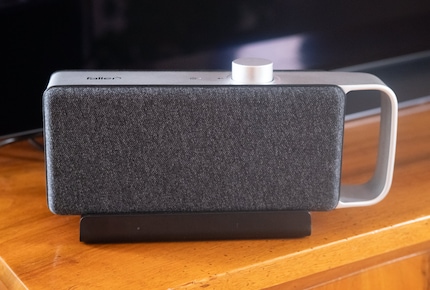

Oskar helps hearing impaired audiences understand the TV
Oskar by the brand Faller is a voice amplifier for the TV. It was made for those with a hearing impairment. My wife has tested it and doesn’t want to give it back.
My partner has been wearing a hearing aid since she was in school. She doesn’t wear it at all times of the day because she can have normal conversations without a hearing aid. She also wouldn’t wear it when watching TV, as we often watch them in the original language with subtitles anyway.
One problem she did have was series and movies in German. In German productions or dubbed versions, we had to put the subtitles on because my wife simply didn’t understand the dialogue. On the one hand this was likely due to the large dynamic range (see info box). On the other hand it’s probably because of her hearing impairment.
That’s where Oskar comes in: a handy device no bigger than a kitchen radio that promises to amplify the voices of television signals.

Super simple and yet well thought out
The principle is simple: a base station is connected to the TV via an optical cable or a 3.5 mm jack. There’s no HDMI port like in soundbars. The base station is used to charge the speaker and it automatically establishes a wireless connection.
The box itself has a handle, a volume knob that turns the device off when set to zero, and a button for three different audio profiles. Two LEDs on the side indicate the connection status and the battery charge level. There’s also a USB-C port to charge the speaker away from the base station and a 3.5 mm jack output for headphones. For such a device, it’s got everything you need.

Source: Simon Balissat
The three levels you can choose from are supposed to isolate the voices to varying degrees. We only use the highest setting. Neither my wife nor I could make out any difference between the three levels. Just like when you use the hoover – you always turn it to the highest setting.

Source: Simon Balissat
Scepticism gives way to confidence
I install Oskar via the optical cable and configure my TV so that the TV speakers continue to output a signal. After all, we don’t just want to hear filtered voices, but the other sounds too. Straightaway, you notice that there’s quite a delay between the TV sound and Oskar. Fortunately, this can be synchronised in a submenu of the TV.
We first watch a movie in English with subtitles and put Oskar on the armrest of the sofa. My wife is immediately thrilled because we’re not turning the TV up and down constantly. I only find it annoying at the start as the voices aren’t coming from the centre of the room, but from my left – where the box rests on the armrest. But my brain soon switches over and gets used to it. Audiophiles would probably be bothered by this.

Source: Simon Balissat
She doesn’t want to give Oskar back!
Oskar passes the real test in the days and weeks that follow. Whether it’s a TV series in German, movies in English or the daily news, everything is watched with Oskar. «Can we keep it? Pleaaase!», my wife texts one evening out of nowhere. The speaker is a real relief for her. Finally, she no longer needs her over-ear headphones when she watches TV on her own and we can watch movies and series together more easily.
I would classify the sound quality in the range of a Bluetooth box, whereby – as intended for the purpose – the low frequencies aren’t present at all. The frequency range of the human voice starts around 80 Hz and goes up to 10 kHz. Oskar has mastered this spectrum and filters out too low or high tones skilfully.
Conclusion: an innovation for the hearing impaired
Oskar makes it immensely easier for my wife to enjoy TV without me being too distracted by the little box. On the contrary: I, too, appreciate it when the dialogue is somewhat more distinct and understandable. A simple device that makes her free time much easier. It’s a real innovation for people with a hearing impairment.
When I flew the family nest over 15 years ago, I suddenly had to cook for myself. But it wasn’t long until this necessity became a virtue. Today, rattling those pots and pans is a fundamental part of my life. I’m a true foodie and devour everything from junk food to star-awarded cuisine. Literally. I eat way too fast.
These articles might also interest you

Product test
Sony Theatre U review: can you really get surround sound with this shoulder speaker?
by Luca Fontana

Product test
A TV sound that makes walls shake: Sennheiser Ambeo Plus
by Florian Bodoky

Product test
Bose Smart Ultra Soundbar: High-end look, but how does it really sound?
by Florian Bodoky